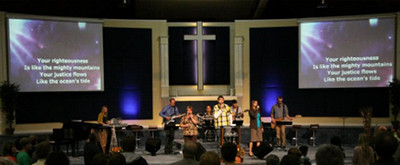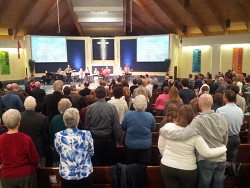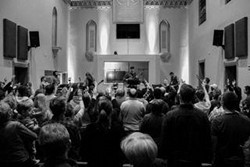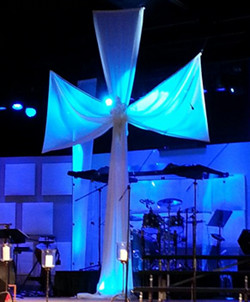
Most houses of worship share two acoustical needs. Meeting these needs will help foster the growth of the worship community by creating a more successful worship environment.
The first need is to deliver a high quality, intelligible, spoken message. Faulty acoustics impede the congregation’s understanding of the speaker’s message and interfere with the listener’s concentration. Speech intelligibility should be clear and strong across the front, middle, back, and along all sides of the room.
The second need is performing music in the form of singing or musical instruments. Whether playing traditional music with choirs, organs, and pianos, or performing “energy” music using guitars, drums, keyboards, and singers, poor acoustics can influence the congregations’ understanding and ability to join in with praise music.
Gathering areas separate from the central sanctuary will also benefit from acoustic treatments. Simple, yet effective, sound control treatments will improve the sound and cultivate the necessary privacy throughout gymnasiums, fellowship halls, meeting rooms, offices, and other support spaces.
Common Causes of Poor Acoustics
The typical architectural structure of worship houses consists of many hard, reflective surfaces that allow sound waves to freely bounce from wall to wall. Slap-back, flutter echoes, “dead” sound, and sound that the congregation just cannot hear are common complaints, especially from those that worship in non-traditional spaces.
Before investing in a new sound system, consider the room’s acoustics first. Below we highlight several churches that solved their sound issues with acoustic treatments.

Rothesay Baptist:
Pastor Barry Todd experienced a number of sound issues in the sanctuary of Rothesay Baptist. Slap echo from the front wall created “muddy” noise, and, during musical numbers, instrument sounds bounced and echoed around the room. These problems interfered with congregational singing, sermon intelligibility, and general listening comfort. After treating the room’s front walls, first reflection points, and ceiling with Acoustic Panels, the congregation can now clearly hear the Pastor and follow along with praise music. Pastor Barry Todd says the panels are, “effective in treating their problems and flexible enough to fit our space.”

House of Prayer:
While renovating a retired 1897 Catholic Parish, the House of Prayer Evansville needed to work within the confines of the existing structure. The older architectural designs did not support the modern technologies of sound systems and amplified music, and sound echoed freely throughout the chamber. ATS Acoustic Panels not only offered noise absorption and decreased the echoes, but they also blended seamlessly into the architectural elements of the beautiful church.
Frisco Bible Church:
Technical Director Ryan Sweeten wanted to improve the flutter echo, slap back, and intelligibility issues in the sanctuary. The congregation especially had trouble hearing their Pastor when he moved around the staging area with his microphone.
Ryan applied Custom Size 8′ x 4′ panels at first reflection points, 2′ x 2′ Acoustic Panels along the front wall, and additional acoustical treatments along the rear wall. He states that the sound improvement is dramatic, particularly during musical numbers. “The acoustic panels help punch up the low end frequencies and provide clearer, solid sound for the kick drums and bass guitars.”
Acoustic treatments are an affordable solution to changing the dynamics and experiences in your worship environment. Learn more about our available acoustical treatments.
Our Inside Sales Engineers are always pleased to give a free analysis of your sanctuary, or to answer any of your acoustical questions.
